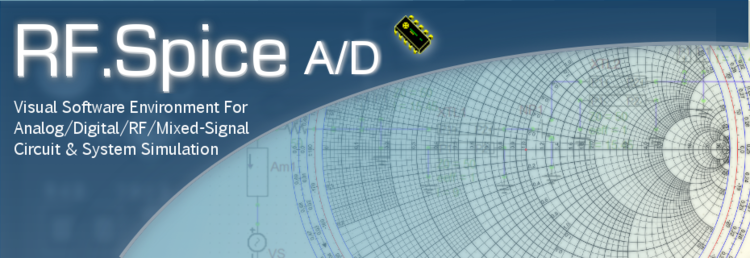Difference between revisions of "RF.Spice A/D"
Kazem Sabet (Talk | contribs) |
Kazem Sabet (Talk | contribs) (→RF.Spice A/D Tutorial) |
||
| Line 82: | Line 82: | ||
* [[RF.Spice A/D Tutorial Lesson 24 | RF.Spice A/D Tutorial Lesson 24: Analyzing a Communications System Using Virtual Blocks]] | * [[RF.Spice A/D Tutorial Lesson 24 | RF.Spice A/D Tutorial Lesson 24: Analyzing a Communications System Using Virtual Blocks]] | ||
| + | Please note that Tutorial Lessons 8, 9, 10, 16, 17, 18, 19, 23 and 24 are not intended for [[B2.Spice A/D]] users, who run the "Lite Edition" of [[RF.Spice]] A/D. | ||
| + | |||
<p> </p> | <p> </p> | ||
[[Image:Back_icon.png|40px]] '''[[Main_Page | Back to Emagtech Wiki Gateway]]''' | [[Image:Back_icon.png|40px]] '''[[Main_Page | Back to Emagtech Wiki Gateway]]''' | ||
Revision as of 17:33, 20 August 2015
Welcome to RF.Spice A/D Wiki!
| |
Notice to Our Valued B2.Spice A/D Users: EMAG Technologies Inc. proudly announces the completion of evolution of our popular B2.Spice A/D product and its transition to RF.Spice A/D, our new comprehensive visual software environment for analog, digital, RF and mixed-signal circuit and system simulation. However, we will continue to support and offer B2.Spice A/D to the public as a very affordable "Lite Edition" of RF.Spice A/D. Please note that we have consolidated the online documentation and tutorial lessons of the two software products. |
RF.Spice A/D Manual
Below are some links to help you get started using RF.Spice A/D:
- RF.Spice A/D: Getting Started
- Navigating the Visual Interface: Workshop & Toolbox
- Working with Schematic Editor
- An Overview of Analog and Mixed-Mode Circuit Simulation
- An Overview of Digital Circuit Simulation
- An Overview of RF Circuit Simulation
- An Overview of System-Level Macromodeling Using Virtual Blocks
- Running Live Simulations with Circuit Animation
- Analyzing Circuits Using Predefined Tests
- Visualizing Simulation Data Using Graphs and Tables
- Running Parametric Sweeps and Monte Carlo Tests
- Working with the Parts Database & Device Manager
- Using Device Manager to Create New Devices and Models
- Creating New Symbols Using Symbol Editor
- Working with Other Applications
Lists
- List of RF.Spice A/D Toolbars, Windows & Menus
- List of RF.Spice A/D Keyboard Shortcuts
- List of SPICE Simulation Parameters
- List of Digital Device Parts
- List of Physical Transmission Line Types
- List of Standard Imported RF Devices
- List of Standard Device Symbols & Their Pins
Parts Glossaries
- Glossary of Signal Sources
- Glossary of Markers and Meters
- Glossary of Generic Analog Devices
- Glossary of Generic Digital and Mixed-Mode Devices
- Glossary of Black-Box Blocks
- Glossary of Generic RF Devices
- Glossary of Physical Transmission Lines and Components
RF.Spice A/D Tutorial
Each tutorial lesson listed below walks you through the basic features of RF.Spice A/D covering many different topics.
- RF.Spice A/D Tutorial Lesson 1: A Simple Analog Voltage Divider Circuit
- RF.Spice A/D Tutorial Lesson 2: Time and Frequency Analysis of an RLC Filter
- RF.Spice A/D Tutorial Lesson 3: Analyzing a Bipolar Junction Transistor (BJT) Circuit
- RF.Spice A/D Tutorial Lesson 4: Designing Op-Amp Amplifiers
- RF.Spice A/D Tutorial Lesson 5: Building a Three-Input Digital AND Function
- RF.Spice A/D Tutorial Lesson 6: Analyzing CMOS Logic Circuits
- RF.Spice A/D Tutorial Lesson 7: Exploring Flip-Flops and Sequential Logic Circuits
- RF.Spice A/D Tutorial Lesson 8: A Simple Transmission Line Circuit
- RF.Spice A/D Tutorial Lesson 9: Network Analysis and Smith Chart
- RF.Spice A/D Tutorial Lesson 10: Analyzing Microstrip Lines, Discontinuities and Filters
- RF.Spice A/D Tutorial Lesson 11: Creating a New Part from Your Circuit
- RF.Spice A/D Tutorial Lesson 12: Creating a Parameterized Subcircuit Part
- RF.Spice A/D Tutorial Lesson 13: Building Your Own Reusable Binary Adder Digital Device
- RF.Spice A/D Tutorial Lesson 14: Analyzing an Integrated Circuit Voltage Comparator
- RF.Spice A/D Tutorial Lesson 15: Designing Active Filters Using Op-Amps
- RF.Spice A/D Tutorial Lesson 16: Designing a Distributed Bandpass Filter Using Coupled Lines
- RF.Spice A/D Tutorial Lesson 17: Impedance Matching Using Tuning Stubs
- RF.Spice A/D Tutorial Lesson 18: Designing a BJT RF Amplifier with Lumped Elements
- RF.Spice A/D Tutorial Lesson 19: Analyzing Distributed Amplifiers with Imported BJT & FET Models
- RF.Spice A/D Tutorial Lesson 20: Designing Low and High Frequency Oscillator Circuits
- RF.Spice A/D Tutorial Lesson 21: Building Mixed-Mode Circuits and D/A Converters
- RF.Spice A/D Tutorial Lesson 22: Using Switches to Build Sample-And-Hold Mixed-Mode Circuits
- RF.Spice A/D Tutorial Lesson 23: Time Domain Simulation of RF Components and Circuits
- RF.Spice A/D Tutorial Lesson 24: Analyzing a Communications System Using Virtual Blocks
Please note that Tutorial Lessons 8, 9, 10, 16, 17, 18, 19, 23 and 24 are not intended for B2.Spice A/D users, who run the "Lite Edition" of RF.Spice A/D.
